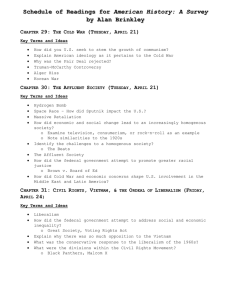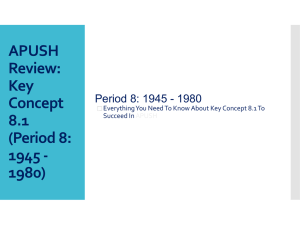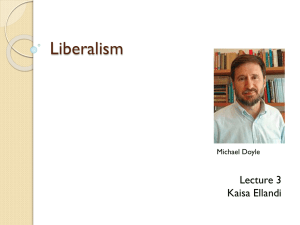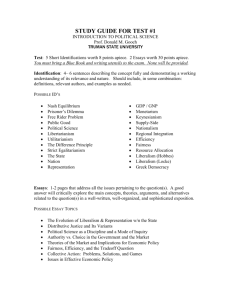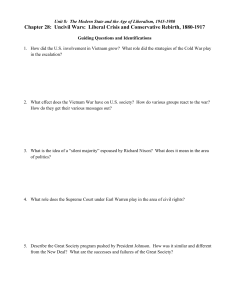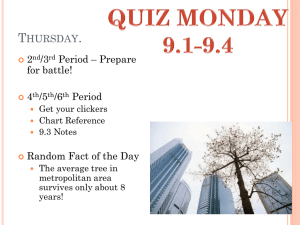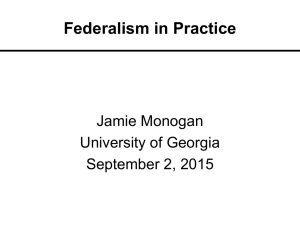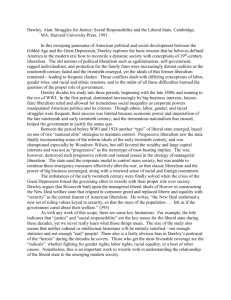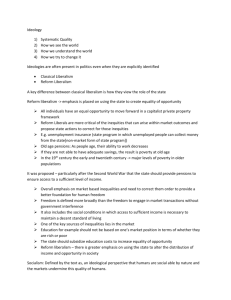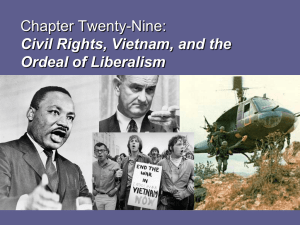APUSH Review: Key Concept 8.2 (Period 8: 1945
advertisement
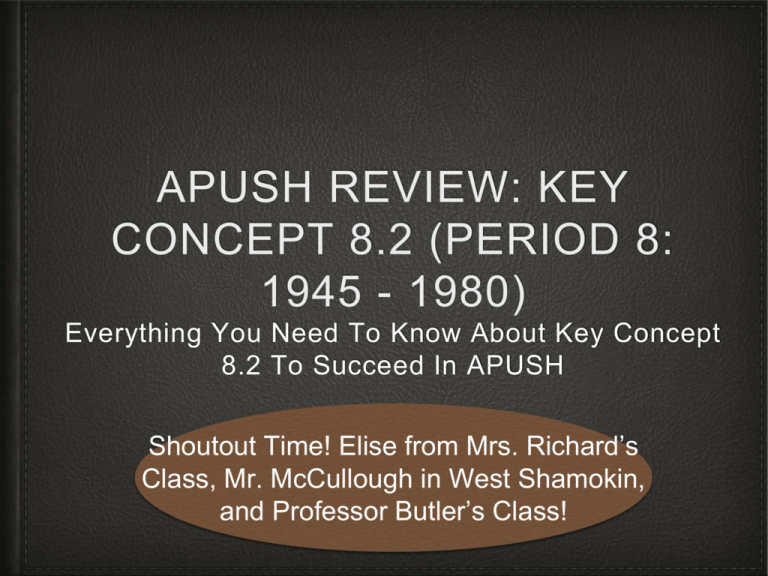
APUSH REVIEW: KEY CONCEPT 8.2 (PERIOD 8: 1945 - 1980) Everything You Need To Know About Key Concept 8.2 To Succeed In APUSH Shoutout Time! Elise from Mrs. Richard’s Class, Mr. McCullough in West Shamokin, and Professor Butler’s Class! Key Concept 8.2 • “Liberalism, based on anticommunism abroad and a firm belief in the efficacy of governmental and especially federal power to achieve social goals at home, reached its apex in the mid-1960s and generated a variety of political and cultural responses.” • Page 74 of the Curriculum Framework • Big Idea Questions: • What were some examples of successes during the Civil Rights Movement? How did the federal government contribute to this? • How did awareness for groups such as Latinos, American Indians, Asian Americans, women, and gays and lesbians change during this time? • Why were some people on the left and right assailing liberalism? Key Concept 8.2, I • “Seeking to fulfill Reconstruction-era promises, civil rights activists and political leaders achieved some legal and political successes in ending segregation, although the progress toward equality was slow and halting.” - page 74 • A: After WWII, civil rights activists used a variety of strategies to challenge racial segregation • Legal challenges: NAACP cases, led by attorney Thurgood Marshall, future Supreme Court Justice • Direct action: Fannie Lou Hamer and Freedom Summer • Sought to increase the number of African Americans registered to vote in Mississippi • Nonviolent Protest tactics: • Montgomery Bus Boycott • Sit-ins - Greensboro, NC -> sit-ins across the country Key Concept 8.2, I • B: All 3 branches helped promote greater racial justice: • Executive - Harry Truman’s Executive Order 9981 desegregated the US military in 1948 • Judicial - Brown v. Board - ruled that segregation was inherently unequal, overturned Plessy v. Ferguson (1896 - period 6) • Legislative - Civil Rights Act of 1964 - part of LBJ’s Great Society, which was an extension of the New Deal, and focused on Civil Rights • Discrimination in the workplace became illegal • Guaranteed equal access to public accommodations Key Concept 8.2, I • C: White resistance slowed efforts at desegregation • “Massive Resistance” - Southern schools would shut down before desegregating • Southern Manifesto - 101 Congressmen that believed the Supreme Court overstepped its power • Little Rock Nine - Governor Orville Faubus refused to integrate schools, Eisenhower sent troops to enforce integration • Post-1965 (riots in cities, increased involvement in Vietnam) debates emerged among activists over tactics and philosophy: • MLK - still urged nonviolence, but some urban protestors were frustrated • Black Panthers - advocated armed self-defense to violence Key Concept 8.2, II • “Stirred by a growing awareness of inequalities in American society and by the African American civil rights movement, activists also addressed issues of identity and social justice, such as gender/sexuality and ethnicity.” - page 74 • A: Challenges to society’s assumptions about gender • Betty Friedan’s The Feminine Mystique - argued that many housewives (especially suburban) were not happy and felt they lived unfulfilled lives • Gloria Steinem - helped create the National Women’s Political Caucus • Supports women that seek to be involved in politics • Step-mother of Christian Bale! • Calls for social and economic equality for gays and lesbians: • Stonewall Riots (1969) - birth of the Gay Rights Movement Key Concept 8.2, II • B: Groups that demanded social and economic equality and to redress past grievances included: • Latinos: • Cesar Chavez and the United Farm Workers • Led a grape pickers’ strike to bring attention to the plight of MexicanAmerican workers • American Indians: • Indians of All Tribes (IAT) and American Indian Movement (AIM) used protests to bring attention to the struggles of Native Americans • IAT took over Alcatraz Island in 1969 • Asian Americans: • California overturned its Alien Land Law - forbade Japanese immigrants from owning land Key Concept 8.2, II • C: Although it appeared there was overall affluence, poverty was a national issue, and efforts began to address it • Michael Harrington’s The Other America • Helped influence LBJ’s Great Society • Argued 25% of the nation and 40% of African Americans lived in poverty • Native Americans were the hardest hit group Key Concept 8.2, III • “As many liberal principles came to dominate postwar politics and court decisions, liberalism came under attack from the left as well as from resurgent conservative movements.” - page 75 • A: LBJ’s Great Society was the high point of liberalism and sought to: • Use federal power to end racial discrimination: • Civil Rights Act of 1964 - banned discrimination in public facilities • Voting Rights Act of 1965 - eliminated literacy tests, federal government could register voters • 24th Amendment - eliminated poll taxes • Eliminate poverty: • Head Start Program, HUD • Foodstamps, Medicare, and Medicaid • Address other social issues and attack communism abroad: • Education - provided $ for primary and secondary education • Vietnam War - sought to keep communism from spreading Key Concept 8.2, III • B: Liberal ideas were aided by: • Supreme Court Decisions that expanded democracy and individual freedoms • Miranda v. Arizona - those arrested must be made aware of their rights • Griswold v. Connecticut - struck down a law forbidding contraception; determined the Constitution established a “right to privacy” • Great Society social programs and policies • Power of the federal government • Impacts of those above? • Emergence of a conservative movement that focused on: • Defending traditional visions of morality • Debating the proper role of state authority Key Concept 8.2, III • C: Groups on the left assailed liberals because they believed: • Liberals did not transform the racial and economic status quo at home • Black Panthers - urged arming of African Americans for self defense; created free breakfast programs in urban areas • Liberals pursued immoral policies abroad (Vietnam War) • Students for a Democratic Society (SDS) - protested the Vietnam War as the US increased involvement; criticized the gap between the rich and poor • Inspired march-ins, sit-ins, and teach-ins Test Tips • Multiple-Choice and Short Answer: • Examples of strategies used by Civil Rights Activists - direct action, legal challenges, and nonviolent protest • How all three branches contributed to the Civil Rights Movement • Great Society - EVERYTHING • Criticisms of liberalism on the left and right • Essay and DBQ: • Comparing the Civil Rights movement with earlier time periods (1890s - 1920s - Booker T., W.E.B., etc.) • Comparing the Women’s Rights movement with earlier time periods (1840s, 1920s, etc.) See You Back Here For 8.3! • Thanks for watching! • Subscribe and share • Good luck on all your tests and in May!
